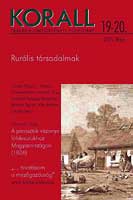Angol játék a magyar gyepen. A Magyar Gazdasági Egyesület előtörténete
An English game on the Hungarian turf – the pre-history of the Hungarian Economic Society
Author(s): András VáriSubject(s): History
Published by: KORALL Társadalomtörténeti Egyesület
Keywords: Hungary; social history;19th century; Reform Age; aristocracy; societies; economic reform; horse races; horse breeding; István Széchenyi
Summary/Abstract: The Hungarian Economic Society was one of the strongest lobbies in the last third of the nineteenth century. Here we have a look at its inception in the 1820-ies. This was not at all of an economic nature. The predecessor was an informal society of aristocrats and great landowners organizing horse-races. This friendly informal gathering has evolved slowly and gradually into a regular association. The gradual character was itself a pointer to the fact, that there was an effort to be made here. On the one hand, the transformation went in the direction of formal association, something that was not quite the usual aristocratic societal form. On the other hand, although the gentlemen were in every land and in every age horse-lovers, here the Hungarian aristocrats did need to learn a new set of social roles, a body of technical knowledge and – a “culture”. They have learnt from England and the English aristocrats, consciously and continuously, the word “imitate” would not be amiss here. Therefore, the present paper starts by taking a look at the development of the enthusiasm of the English aristocracy for sports, games and specifically, for horse-racing in the Napoleonic period and afterwards. It seems that there was indeed a deeper meaning of these fashions, and it had to do with a certain unease emerging in the traditional aristocratic social role. The importer of these fashions into Hungary was always held to be Count István Széchenyi, but as a matter of fact there were a number of other lords participating in the same effort. It is conspicuous, when looking at the social structure of the different informal societies and bodies of associations promoting horse-racing in Hungary, what a large proportion was made up by members of court society or high-ranking officers. By the same token, in the Hungarian races there were always quite a number of the aristocratic families from the Western half of the Empire, and vice versa there was a substantial group of Hungarian aristocrats represented in the races and clubs in the Austrian half of the Empire. All that suited the plans and designs of Count Széchenyi fine. Horse racing was meant by him to be the field of individual self-perfection, an area of moral and social accomplishment and rejuvenation of the aristocracy that Count Széchenyi thought to declining in every way, and to be one of a number of ways of bringing together and civilizing Hungarian society. The success of a society for horse-racing was probably ensured by the patronage of the aristocracy in the first place and the avowed non-political nature of the society in the second. By about 1834 the society was, on account of its membership and income, a success. But at the same time there was a new agenda emerging: horse and sheep breeding, that was starting to take even further away from a passion for horses and the fun of racing towards the more serious business of developing a backward economy.
Journal: Korall - Társadalomtörténeti folyóirat
- Issue Year: 2005
- Issue No: 19-20
- Page Range: 99-131
- Page Count: 33
- Language: Hungarian

